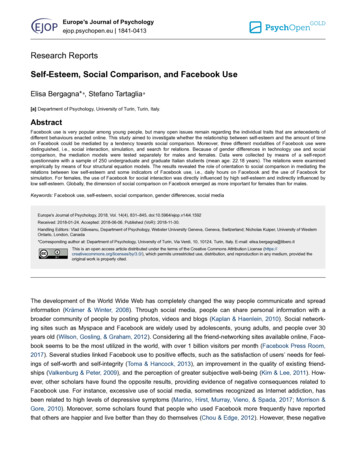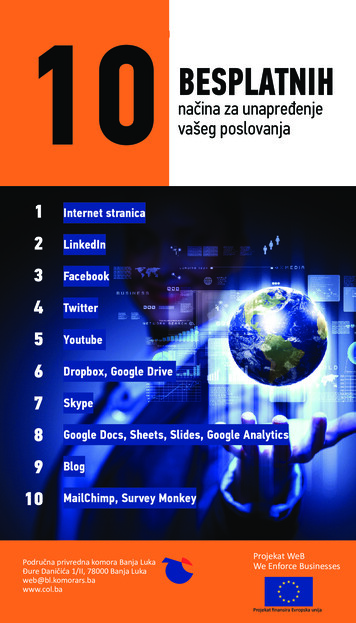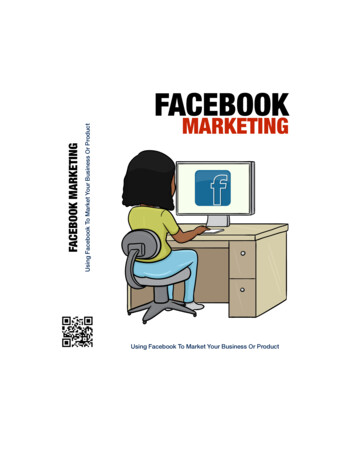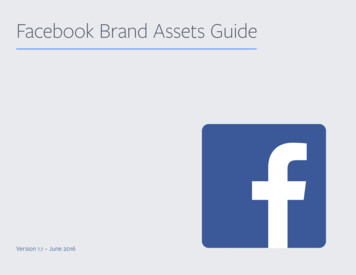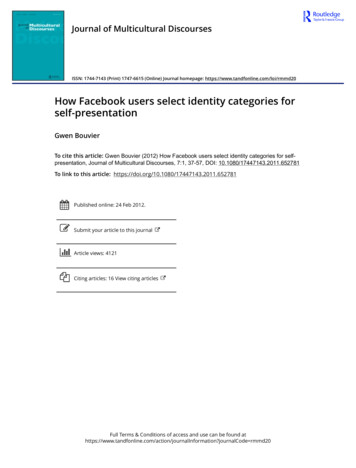
Transcription
Journal of Multicultural DiscoursesISSN: 1744-7143 (Print) 1747-6615 (Online) Journal homepage: https://www.tandfonline.com/loi/rmmd20How Facebook users select identity categories forself-presentationGwen BouvierTo cite this article: Gwen Bouvier (2012) How Facebook users select identity categories for selfpresentation, Journal of Multicultural Discourses, 7:1, 37-57, DOI: 10.1080/17447143.2011.652781To link to this article: hed online: 24 Feb 2012.Submit your article to this journalArticle views: 4121Citing articles: 16 View citing articlesFull Terms & Conditions of access and use can be found ation?journalCode rmmd20
Journal of Multicultural DiscoursesVol. 7, No. 1, March 2012, 37 57How Facebook users select identity categories for self-presentationGwen Bouvier*Cardiff School of Creative & Cultural Industries, University of Glamorgan, UK(Received 8 November 2011; final version received 20 December 2011)This paper focuses on the display of identity on Facebook, and more specificallyon how undergraduate students in Cardiff, Wales, say they express identity ontheir profiles. The theoretical context of this study is observed processes of changein the way we play out identity through what have been described as globalisation,deterritorialisation and the rise of lifestyle consumer society. The paper is basedon an analysis of responses from a questionnaire and interviews with 100 studentsfrom Media and Communication degrees at the University of Glamorgan. Thedata collection is designed to indicate what kinds of self-categorisation are used.These data are analysed using Social Actor Analysis developed by Machin andVan Leeuwen. The paper shows that we find a range of identity categories, somethat are based around a biological model of national identity, while others focuson a belonging to a territory, others on national cultural activities and yet otherslink to lifestyle identity. What is most notable in this Welsh sample is the highuse of nationalist identity categories and biological ethnic classification alongsideother lifestyle identities.Keywords: discourse; identity; Facebook; small nations; nationalismIntroductionThis paper offers a specific contribution to the emerging literature on the display ofidentity on Facebook. In 2011, the social networking site has more than 800 millionactive users, of which over 50% log into their profiles on a daily basis (Facebook2011). A number of observers have noted that there is need for more research tounderstand how users present themselves to communicate about themselves in theseenvironments (Livingstone 2008). Such social networking sites have been thought tooffer new opportunities for more careful management and presentation of selfin social networks and friendship communities. Thus far, much of the literature askshow resources are used to communicate identity, and there has been a tendency toemphasise the way that users are free to create and manage these identities, althoughthis has been examined more at a theoretical rather than empirical level. This hasbeen considered in the way that users may wish to make themselves appeal to specifictarget communities or kinds of users.Here I want to think about precisely what categories of identity people use andwhat they do not use to do this, asking: ‘does Facebook foster particular kinds ofidentity categories as users are involved in participating in social networks andcreating community links?’ It is a commonly asked empirical question in academic*Corresponding author. Email: gbouvier@glam.ac.ukISSN 1744-7143 print/ISSN 1747-6615 online# 2012 Taylor & 781http://www.tandfonline.com
38G. Bouvierfields such as Sociolinguistics: ‘when called to define identity in any given setting,what kinds of resources are used?’ Such a question is not necessarily posed in thesame way in Cultural Studies, where much of the emerging research has beenproduced, and which is generally concerned less with specific linguistic resources andtheir use. But here I want to show that it is productive to do so in this context.In any given social context at any given time, there is a range of identity conceptsavailable that should be seen as socially constructed (Foucault 1982). And further,according to Foucault those resources that are in play at any given time often giveus a lead on the kinds of power structures in a social context even if users have asense these are used by choice and present a positive and liberating classification(Machin and Van Leeuwen 2007). We can then question whether through this,certain kinds of identity are fostered and maintained. In the case of Facebook, whilethere has been some celebration of the freedom to create identity, it is a useful stepto look at the kinds of language resources, the kinds of identity concepts, that areused to do so in a given context.We might see the context of this study as the observed processes of change inthe way we play out identity through what have been described as globalisation(Giddens 1991), deterritorialisation (Negus and Roman-Velazquez 2000) and the riseof lifestyle consumer society (Chaney 1996). Theorists have observed on the onehand that these forces offer newer, powerfully compelling forms of identity, basedfor the most part around consumer and lifestyle factors that displace the meaningfulness of national identity. On the other hand, others have noted the emergence orresurgence of new kinds of nationalism at symbolic levels celebrated through thingslike cultural events (Billig 2002).In Wales in particular, there has been a resurgence in national identity at certainlevels, especially since the 1990s through the process of devolution, with theestablishment of the National Assembly and financing of the Welsh Languagewhich has lead to a resurgence in some parts of Wales (Jenkins and Williams 2000,xiii). In the second decade of the twenty-firstcentury it appears that there is certainlya resurgence of Welsh nationalism, at least at the symbolic level, where new streetsand public buildings will be given names from the Welsh language even if localshave little knowledge of it (Coupland 2010). Yet these new symbolic forms ofnational and cultural identity, some of which appear to point to a monolithic ethnicWelshness, have been shown to be just as imagined as the nations described byAnderson (1991) in his classic work Imagined Communities and as much constructedand mythologised as described by Gellner (2006) and Hobsbawm (1997). Bohata(2004, 15) points to the way that the idea of a nativist Welsh culture is absurd bylooking back at a pre-colonial past to salvage what is conceived to be the essential,pure culture that existed prior to the moment of colonialisation (Bohata 2004, 129).Nevertheless, as with nationalism, a particular place becomes fused with ‘mythicalcontent and hallowed sentiments’ (Williams and Smith 1983, 509). Bhabha notesthat the nation can no longer be considered a material reality. It is rather a formof discourse, in which imaginative processes inevitably assume a central role(Bhabha 1994). The same applies to ethnic categories. And what we find in thisstudy is a predominance of this kind of identity being foregrounded on Facebookprofiles in this sample.In the context of Welsh culture, Ashcroft, Griffiths, and Teffin (2007, 79) notesthat ‘only a few aspects of traditional culture need be selected as ‘‘symbolic elements’’around which ethnic identity revolves, and individuals need experience very few of
Journal of Multicultural Discourses39the defining criteria [. . .] to consider themselves members of the group’. They pointout a lack of agreement on the nature and specific features of ethnicity amongstmembers of ethnic groups, underscoring the incompleteness of such a grouping.Nevertheless, this active intertwining of elements of identity has come to functionas an increasingly potent arrangement of identity in a world that is progressivelymore migratory, globalised and hybridised (2007, 79). Since Facebook embodiesmany of these features the online environment is global and deterritorialisedand of course people living in Wales inhabit an advanced capitalist economy wherelifestyle identities now flourish it is of interest to look at the ways that Welsh usersclassify themselves.This paper is based on an analysis of responses from a questionnaire andinterviews with 100 students from Media and Communication degrees at theUniversity of Glamorgan in South Wales, UK, who had Facebook profiles andwho all identified themselves as regular users. These students were questioned asto how they express their identities on their personal profiles, if indeed they doat all. In other words, the data collection is designed to indicate what kinds ofself-categorisation are used and how this is accomplished. The research was relatedto a broader project regarding identity and small nations but the data that wasthrown up led to the broader considerations of identity expression that form theanalysis in this paper.These data are analysed using Social Actor Analysis (Van Leeuwen 1996)specifically as developed and applied by Machin and Van Leeuwen (2007). This isa sensitive framework through which features of identity can be monitored andcategorised. The paper shows that we find a range of identity categories, somethat are based around a biological model of national identity, while others focuson a belonging to a territory, others on national cultural activities and yet otherslink to lifestyle identity. Some users distanced themselves from Welsh classification. Useful in this approach is Shi-xu’s (2005) reminder that discourses are alwayscultural-politically competing, socially dynamic and diverse. It is out of this process,ultimately, that culturally shared notions of things like national and ethnic identityemerge and change over time. What is ‘Welsh’ is by no means fixed nor monolithic.Welshness in Shi-xu’s terms is a cultural phenomenon and nothing more or less. Butnevertheless, discourses, we should not forget, are ‘at the heart of personal, social,historical and cultural reality and the construction of action upon reality’ (2005, 40).Research on Facebook and identity presentationThe research carried out for this paper is to be located in the emerging body ofliterature on social networking sites. Much of this literature has explored the kindsof contacts made on Facebook and pointed broadly to the processes of selfpresentation of identity undertaken by users. A review of this work and the questionsit raises shows that it is a useful step to ask, using Social Actor analysis, whatcategories of self users both highlight and background when constructing theirprofiles. The precise value of this particular research question will become cleareras the different threads of research into Facebook are reviewed in turn.Much of the research on Facebook specifically has focused on ‘friending’,identity performance on personal profiles and within groups, and privacy/securityissues (Honeycutt and Cunliffe 2010, 229). It is the first two of these that are ofrelevance here, since this paper is concerned with the process by which users position
40G. Bouvierand present themselves to others to create and maintain connections and to presentthemselves in a fashion according to those they wish to seek out, or identify.‘Friending’Early research on identity and Facebook focused on processes of ‘friending’.1 Itwas debated whether initiating new contacts would lead to meeting new peopleface-to-face (Parks and Floyd 1996) or whether connections were being forgedwith people outside of users’ pre-existing social or geographical circles (Wellmanet al. 1996). However, as social networking sites like Facebook have becomemainstream media, research has shown that this has not been the case. Lampe,Ellison, and Steinfield (2006, 169) found that social networking sites are used in thefirst place as a tool to maintain established connections (see also Chiung-Wen,Ching-Chan, and Yi-Ting 2011).There has been more concrete research that has attempted to log the exactnature of the kinds of connections created through social networking sites, whichhave been argued to consist of jumbled, mixed collections of contacts, ranging fromold school-friends, relatives, close friends and other people they met randomly(Lewis and West 2009, 1209). But subsequently the question has been asked whetherthere is a need to find out more about the function and nature of the differentkinds of contacts in users’ long lists of ‘friends’ (Tong et al. 2008; Davis et al. 2011).One area that has only just begun to be explored, as in the work of Livingstone(2008), is the way that users actually position themselves to engage with particularcommunities or kinds of other users. The importance of this matter can be clarifiedby a look at the other main thread of work on Facebook, that of ‘identity’.Identity performance on personal profilesTheorists working on identity performance on social networking sites have tendedto draw on the work of Goffman (1959). As in everyday life, there is a process ofself-presentation on social networking sites, where we perform who we are, managingthis in various ways at different times and contexts. But the difference betweenthe two, as perceived by most commentators, is that on social network pages thishas been more reflexive as users have much more time to carefully craft theirdisplayed identity (Champagne 2008, 164).The attention of some authors has been drawn to the way that displayedidentity on Facebook may have only limited correspondence to that in the ‘real’world (Sunden 2003, 109). Indeed, while creating fake profiles has been outlawedon Facebook, hijacked identities (posing as Hollywood stars, for example) or whollyfictitious personas do exist on the site (Westlake 2008, 29). As such, debate hasbeen ongoing about whether Facebook profiles are used to create and communicateidealised versions of selves, or whether social networking sites serve as an extension of our social context in which one’s actual personality characteristics can beexpressed (Vazire and Gosling 2004; Ambady and Skowronski 2008; Manago et al.2008; Back et al. 2010). Other writers suggest that with the routine everyday useof these technologies, the simple distinction between offline and online no longercaptures the complex interrelationship that characterises use and the way media likeFacebook are embedded into lives, particularly amongst young people (Livingstone2008).
Journal of Multicultural Discourses41Others have focused on the interactive nature of self-presentation on socialnetworking sites. Boyd and Heer (2006) suggest that users are key in shaping thepresentations of others as they provide their own comments and Wall postings.User presentations take into account the diversity of an audience consisting offamiliar and not-so-familiar social relationships (DiMicco and Millen 2007). TheFacebook community can be conceptualised as a team performance, achievingGoffman’s (1959, 83) ‘dramaturgical cooperation’ in confirming each other’sperformances of self (Westlake 2008, 27).Some authors have pointed to the way that identity is performed on personalpages through a combination of text, image and sound (Lampe, Ellison, andSteinfield 2007, 1). Such crafted representations are ‘purposeful and outer-directed’and ‘self-production is heavily narrated’, pointing to the connection between userprofiles and the mainstream culture industry (Hearn 2008, 197). Many users willprovide access to their daily ‘diaries’, complete with photographs that may or ofcourse may not be heavily selective. Zhao, Grasmuck, and Martin (2008) found thatusers do not necessarily create personal artefacts but prefer to display material(quotes and images, for example) that are in the public domain. As such, theseusers ‘predominantly claim their identities implicitly rather than explicitly; they‘‘show rather than tell’’ and stress group and consumer identities over personallynarrated ones.’ (2008, 1816).What as yet remains to be more fully explored and documented are some of themore precise ways that users do present themselves for specific groups of others.In this context Livingstone (2008, 396) appears to be taking the lead by asking theright level of empirical question how do users present themselves to approachthe right networks? In this paper I look at how users speak about the way theypresent identity, through a range of semiotic resources, specifically with an interest inthe kinds of categories of identity they use. One of the central concerns of discoursestudies is the way that discourses, values, ideas and identities are disseminated,maintained and legitimised in society. If here we take the idea of team performanceof identity, rather than an identifiable elite media source as is commonly the siteof analysis in discourse studies, we can nevertheless monitor what kinds of identitiesand therefore values, ideas and broader discourses are present on Facebook.Changing concepts in identity research and ‘regimes of identity’This paper also draws on, and sees relevant, key issues in current identity theory inSociology and Linguistics. Particularly relevant are discussions of the constructednature of identity and the changing ‘regimes’ of identity under which we live(Machin and Van Leeuwen 2008). Under each of these regimes different resourcesare available for defining the self and these always reflect the interests of thosein power at each time (Machin and Van Leeuwen 2007). It is this assumption andthe classificatory framework offered by Machin and Van Leeuwen that formsthe theoretical and methodological basis of this paper. This section sets out thedeveloping theory on identity to locate this research, then moving into themethodological framework.The first of the regimes of identity is that of the nation state. Here identity isabout us belonging to a nation state which is constructed as timeless and more orless populated by a monolithic people (Gellner 2006). Anderson (1991) looked atthe role of the rise of the printing press in the ability of a nation state to create a
42G. Bouviersense of shared membership of an imagined community of others that we willnever meet, and many of whom we will have very little in common with. Gellner(2006) shows how these nation states are in fact, despite their self-presentation astimeless, fairly recent social constructions. Machin and Van Leeuwen (2008) haveanalysed the kinds of categories of identity fostered by the nation state as part oftheir interest in controlling and mobilising populations. In the ideology of thenation state people are not to think about themselves in terms of social class,occupation, family connections or relative poverty, but by provenance, in terms ofwhere you are from. Abousnnouga and Machin (2008) have shown the deliberatefostering of the Welsh identity that took place after First World War, which wasa reaction to fear of the left wing politics of the working classes in South Walesat that time. The work of some of the key thinkers in Sociology, such as Simmel(1917), Tönnies (2001) and Durkheim (1897), was highly concerned about the shiftfrom identities based in those of small rural communities to those based on theanonymous large-scale society that insisted on the category of the more abstractednational identity.The second regime of identity is that of lifestyle. Identity expressed throughlifestyle can rest on the use of signs that are loaded with cultural meaning. Zablockiand Kanter (1976, 270) noted that lifestyle is a major element of identity formulationfor those ‘for whom identity has come to be generated in the consumption ratherthan in the production realm’. Though it can rightly be said that people useconsumption and consumer goods to express their selves, such markers of lifestylealso use them, as consumers are tracked and monitored through marketing surveysand the large corporations and social institutions whose interests this serves. (Machinand Van Leeuwen 2008, 54)Identity as a cluster of life(style) choices, then, also provides a person with rules,roles and relationship criteria for living (Walters 1994, 98). Lifestyle thus determinesa range of choices and aims in someone’s life, as a ‘more or less integrated set ofpractices which an individual embraces [. . .] because they give material form to aparticular narrative of self-identity’ (Giddens 1991, 81). Further, the concept oflifestyle does not relate to a resistant relationship to other more essentialist factors of identity or to a dominant culture, but rather emphasises distinctions inpractice with class culture (Chaney 1996, 35). Whereas other regimes of identityare constrained by socially constructed or ‘imposed’ models of identity (such asthe other regimes described here) and by the institutions that maintain them, thearguably more advantageous lifestyle identity has the drawback of being dependenton people’s financial resources (Machin and Van Leeuwen 2008, 55). These authorsnote that in the twenty-first century it is lifestyle identity that has come to thefore as this reflects the interests of large corporations who seek to safely fuse ideas,attitudes and values to consumer patterns.The third regime of identity is that of cultural or ethnic identity. We can saythat cultural identity and ethnicity can be equally as imagined as those reliant onnation. Categories of identity based around ethnic features are often linked intocultural heritage. In Postcolonial studies it has been shown that much of theseclassifications too are constructed, as is national identity. Stuart Hall (1989) hasmentioned the way African identity is often spoken of as if it is something tangibleand timeless. He critically points out that the idea of ‘Caribbean identity’, like‘African identity’, can hide differences within, and obscure how people change. It isthis model of identity which essentialises who we are to a single feature that leads
Journal of Multicultural Discourses43to phenomena such as the tendency to have one black or Asian representative ona committee. Just as if there was something essential about all blacks andAsians that means they could be represented by a single person (Machin and VanLeeuwen 2007).A further important body of literature upon which this paper draws is thataround the nature of identity itself, of how individuals source, construct andnegotiate identity. Self-identity is understood here as an individual’s perception ofwho he or she is, linked to self-assessment and, arguably, continuous re-evaluation.The concept presumes continuity through time and space (Giddens 1991, 53). So,importantly, it is not a distinctive trait but can be considered a response only to aprompt to self-define. Bhabha (1994) emphasises the way that in any society at anytime there are a range of identity categories available to people which they canbring to the fore when necessary, and which can vanish from view for the samereasons depending on what is to be gained or what is perceived to be appropriateor possible. For example, a working-class miner from a town in the Welsh valleysmay consider himself a man, a miner, white, Welsh, a football supporter and afather. Are these identity categories in his mind, or are they simply appearing tohim as facts about his life? This indeed ties in to Giddens’ (1991, 53) notion ofself-identity, which stems from the work of Simmel (1917) and Durkheim (1897):‘[It] is not a distinctive trait, or even a collection of traits, possessed by theindividual. It is the self as reflexively understood by the person in terms of her orhis biography’. So Giddens reflects here on the cognitive component of our identities.There are some categories of self that are, in our society, still assumed to be‘defining’ who one really is. While national identity and provenance may say nothingabout what someone is like, it still has the currency of self-definition.Others, such as Bhabha (1994) have pointed out the way that these categories canbecome practical tools that individuals can use in contexts. There might be manycategories that they can draw upon: black, male, footballer, music fan, lad, mate, hotlover, guy who knows about cars, as well as regional and national affiliations. Indifferent situations any one of these can be brought to the fore.The introduction of this paper mentioned changes in society. Chaney (1996, 2001,2002) has referred to this new society as a lifestyle society where we more or lessself-consciously engineer categories of self that may be more or less permanent.Yet now we might argue that who we are is defined by broader patterns ofconsumption. And certainly we are addressed, and to some extent socially organisedon this basis by corporations. A range of scholars have pointed to this phenomenon(Giddens 1991; Chaney 1996). We might say someone is Welsh only in a momentwhere called to ‘define the true self’, whereas in the rest of our lives we knowourselves according to our lifestyle choices. As yet, these lifestyle categories have notyet become established as acceptable definers of who we really are. Who we ‘are’ maymean that we are more like a person who lives a thousand miles away, but whowatches the same television, wears the same clothes, drives the same car, eats atthe same sushi restaurant, etc. But this is not yet who we can say we are (Machinand Van Leeuwen 2007).Giddens (1991) also suggests that never before have there been so many situations, with contemporary media and mobility, where we are called upon to haveidentity. Bhabha (1994) warns that nevertheless some aspects of identity are takenup as ‘what we are’ in ways that can be less easy to background. An exampleof this is categorisation based on provenance on Diversity Monitoring Forms
44G. Bouvier(Machin and Van Leeuwen 2008). A given person can never cease to be BritishAsian. Even if they were born in Britain and never ever been abroad, they are alwaysone step away from simply being ‘British’ on such classification systems. Howevermuch this person is like their white friends, ‘race’ and regional association (Asia)is something they cannot escape. So we can also ask how much classifications canimprison us and maintain barriers between people that have long ceased to bemeaningful in the globalised world.There is also a debate around the extent to which there is therefore no essentialidentity but rather one that is in flux. Indeed, this ongoing discussion suggests a‘crisis of identity’ is taking place, as the concept has undergone significant shifts inits theorising, with for example Gergen (1991) and Featherstone (1992, 1995)suggesting that the ‘core of the self’ has lost its significance. This allows us to thinkof identity as something that is unstable, changing and constantly fluctuating. Thiscontradicts the way identity was thought about before the globalisation debatesbecame so widespread.Others argue, in contrast, that we must not lose sight of the fact that it isinstitutions such as the nation state and global corporations that often supply uswith these categories of identifying ourselves. And while we may to some extentcontrol them, they also control us (Machin and Van Leeuwen 2008). Identitycategories are not given in nature but created in language, and we cannot describeourselves outside of the categories available in any society at a given time. Powerfulinstitutions will seek to naturalise those that support their own interests. Possibly,the flux model loses sight of this. Whose interest, we must always ask, do theseidentity categories serve?It is this discussion of identity, its changing nature in the context of thelifestyle society, where in the case of Wales there is a new surge in nationalism,but where nevertheless we appear to find ourselves in increasing situations wherewe are called to identify who we are, and in an increasingly globalised anddecontextualised setting. It is into this context that we must understand Facebookand into which we must place the kinds of questions posed earlier of the way peoplemanage identity and engage with different communities through their profiles.Methodology: discourse analysis and Van Leeuwen’s classification of identityconstructionOne key area of interest in discourse studies has been the resources available to andused in any social group for speaking about people as individuals and groups. Theseresources are not simply seen from this perspective as descriptive, but as ideologicallyloaded and serving specific interests. Language is viewed not as simply a way throughwhich we describe the world, but one by which we can creatively form accounts of theworld that reflect our own interests (Kress 1982). Above we have already consideredthe way that the nation state promoted national identities over other kinds of socialallegiances to promote their proper interests, and for example to distract frommatters to do with issues such as poverty, an issue that crosses national boundaries.A number of writers in discourse studies have stressed the usefulness of analysing therepresentational strategies used by authors of texts such as newspaper articles andpolitical speeches. For example, if we find that a journalist in a crime report useslexical choices that draw particular attention to the young age of a group of menaccused of anti-social behaviour (Teo 2001; Mayr and Machin 2012). In this case we
Journal of Multicultural Discourses45could argue that the author, rather than explaining the behaviour in terms of povertyand unemployment, chooses to signify a discourse where youth is out of control insociety.In this paper I draw specifically on the set of tools for assessing representationalstrategies offered by Van Leeuwen (1996) in his paper on social actor analysis asdeveloped
How Facebook users select identity categories for self-presentation Gwen Bouvier To cite this article: Gwen Bouvier (2012) How Facebook users select identity categories for self-presentation, Journal of Multicultural Discourses, 7:1, 37-57, DOI: 10.1080/17447143.2011.652781



